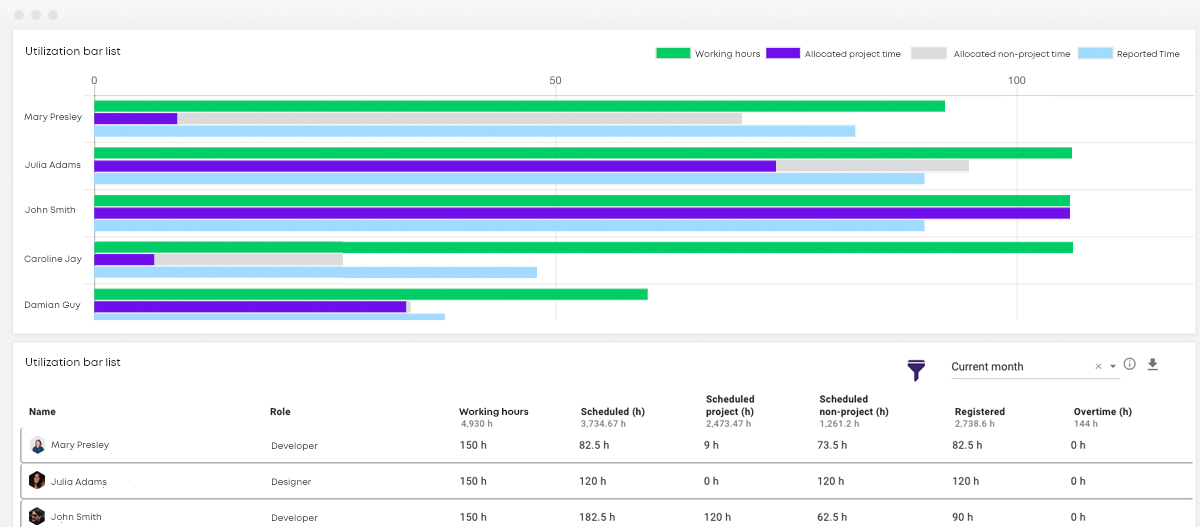How to Keep a Highly Utilized Project Team at 100%?

One of the main KPIs to track in a services / project-based business is utilization levels. Through this measure you’re able to track progress, compare and identify potential problems along the way. But what exactly is team utilization, and what is the best level of utilization to target - is the ultimate goal always a 100%? And, what does this mean for your business in a more practical sense?
What is utilization?
Utilization basically means ‘time spent working’, and is thus a measure of time spent in a productive manner - an effective utilization of available time. There are various ways to track this time, and different methods and definitions of utilized time. This varies from business to business, but what is most important is that you keep a consistent process of tracking utilization. Define and develop the right method for you, and keep this method consistently to ensure a proper way of comparing from phase to phase and across teams and the industry.
Overall, there are three methods of measuring utilization levels. The method of choice depends on your business and preferences.
- Resource Utilization
Resource Utilization, as the name suggests, measures the utilization of your available resources. It’s the simplest mean of measuring utilization. This method simply measures a team member’s time spend on a specific client, internal project or business development. Thus, it includes all time spent in the business; both billable and non-billable time. Thereby, an appropriate utilization level to target would most often be between 80-100%.
- Billable Utilization
Billable Utilization measures the total billable time spent on a client project or task. This method excludes any internal projects or business development which might be a part of the schedule as well. Thus, the utilization levels calculated with the Billable Utilization method will naturally almost always be lower than the Resource Utilization method. Taking this into consideration, an appropriate level to target would probably be between 70-80%, since there will always be time spent on other important tasks that are not directly linked to a client.
- Realization
The Realization measure is basically a measure of how much time was spent directly bringing revenue into the business. Thus, this measure is directly linked to turnover and profitability of each client. Similar to the billable utilization method, it excludes both internal projects, tasks and business development time.
Tracking and measuring utilization correctly
There’s no right or wrong way of tracking, but one thing is very crucial for keeping useful data and measurements. Consistency. Consistency is paramount to ensure a reliable comparable data set from period to period.
Secondly, it’s important to categorize types of tasks into billable and non-billable time. What is billable time in your organization? It is highly recommended that project managers go together and define these categories. Thus, you’ll make sure that each team member doesn’t have to think about where to put each task themselves. This will definitely increase the quality of your data, and make you able to compare different teams.
The initial number that you should start out with is the available hours of each team member. This value can be both with or without company holidays, personal vacations, sick days, etc., but again the key is consistency throughout the organization. Moreover, global companies have to be very aware about differences from country to country; as these standards of measurements may differ, and the same with the amount of holidays, etc.
A great basic number of available hours to start with is 2,080 hours (40 hours per week * 52 weeks). Then from this you subtract holidays and other points. Remember that if you use the baseline, 2,080 hours, in your calculation of utilization - the utilization level will decrease from the beginning, and naturally never reach a level of 100%. Here again, as in the case of the billable utilization method, an appropriate target of utilization would often be between 70-80%. On the contrary, if the baseline excludes holidays, vacation, sick days, etc., then an appropriate level of utilization would often be between 80-100%.
Before deciding on a method for your business, it’s often a good idea to get inspiration from peers, competitors and the standards of your industry. This way it’s easier to compare your data. Moreover, knowing your absolute minimum utilization per resource and bill rate to reach your revenue and margin targets is a great start to compare your data with. Everything above this level will obviously be profitable. This can be a quite complex calculation, or a rather simple one depending on your circumstances.
To calculate the utilization rate (both resource and billable utilization), you simply take the total billable hours, and divide it with the total available hours for the team member. For instance, (1920/2080) = 92%, meaning a utilization level of 92% over the year. If you want rates for more specific time periods, you simply use the appropriate values to match a week, month, quarter, biannual report. Billable time and available time will of course depend on your business, and the working hours, vacation, sick days, etc. of each team member.
To calculate the realization rate; simply take the total billable hours divided by the total available hours. A very basic example would be, (1920*10)/(2080*10) = 92.3%. This is in the case that the 10 team members have the same total billable hours and total available hours.
In order to find the minimum amount to bill your clients, you need to add together all the costs of operation, and set this as a goal to reach. Next you divide it with the total billable hours of the team. For instance, 2,000,000/(1920*10) = 104.17. This means, that you would need to bill your clients at least 104.17 per hour to reach your goal, and make a profitable business. Again, this is in the simple case that all 10 team members have the same amount of billable hours, but otherwise you just use the total billable hours across the team. This measurement will also help you determine the most profitable clients, and eventually refocus and outphase the not so profitable clients.
Through Forecast, you can easily extract some of these numbers simply by going to the ‘Insights’ section, and set up an insight with the portfolio utilization component. Here you’ll get a configurable list of people utilization data for the entire account, e.g. available, scheduled and registered hours.

Stay tuned next week as we dig deeper into the five most important KPIs to track in a digital / professional services organization.
Formulas
Utilization Rate = (Billable Hours) / (Available Hours)
Realization Rate = (Total Billed Hours) / (Total Available Hours)
Minimum to Bill Clients = (Cost of Operations) / (Total Billable Hours)
You might like to read these articles on our blog..
Subscribe to the Forecast Newsletter
Get a monthly roundup of productivity tips & hacks delivered straight to your inbox
